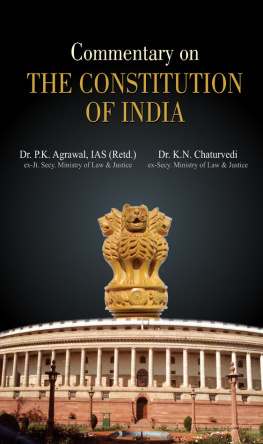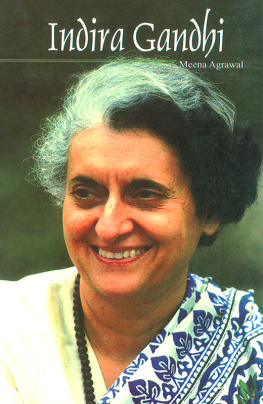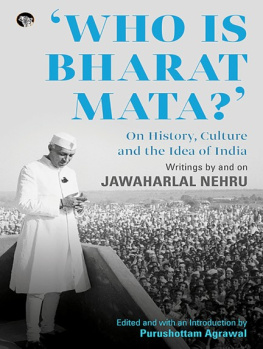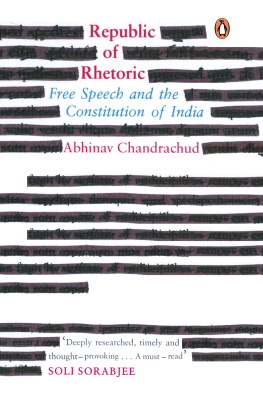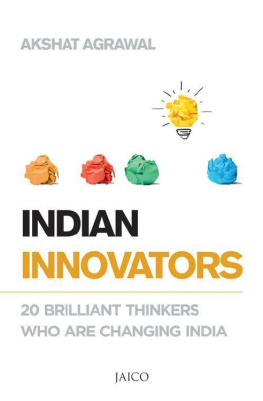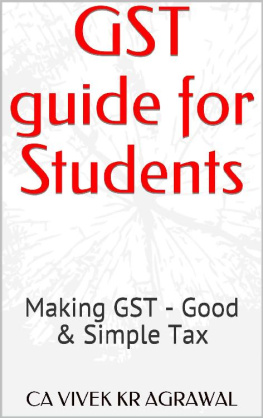DR. P.K. AGRAWAL - Commentary on the Constitution of India
Here you can read online DR. P.K. AGRAWAL - Commentary on the Constitution of India full text of the book (entire story) in english for free. Download pdf and epub, get meaning, cover and reviews about this ebook. publisher: Pabhat Prakashan, genre: Politics. Description of the work, (preface) as well as reviews are available. Best literature library LitArk.com created for fans of good reading and offers a wide selection of genres:
Romance novel
Science fiction
Adventure
Detective
Science
History
Home and family
Prose
Art
Politics
Computer
Non-fiction
Religion
Business
Children
Humor
Choose a favorite category and find really read worthwhile books. Enjoy immersion in the world of imagination, feel the emotions of the characters or learn something new for yourself, make an fascinating discovery.
- Book:Commentary on the Constitution of India
- Author:
- Publisher:Pabhat Prakashan
- Genre:
- Rating:3 / 5
- Favourites:Add to favourites
- Your mark:
- 60
- 1
- 2
- 3
- 4
- 5
Commentary on the Constitution of India: summary, description and annotation
We offer to read an annotation, description, summary or preface (depends on what the author of the book "Commentary on the Constitution of India" wrote himself). If you haven't found the necessary information about the book — write in the comments, we will try to find it.
Commentary on the Constitution of India — read online for free the complete book (whole text) full work
Below is the text of the book, divided by pages. System saving the place of the last page read, allows you to conveniently read the book "Commentary on the Constitution of India" online for free, without having to search again every time where you left off. Put a bookmark, and you can go to the page where you finished reading at any time.
Font size:
Interval:
Bookmark:
Commentary On
The Constitution of India
by
Dr. P.K. Agrawal, IAS (Retd.)
Ex-Joint Secretary, Deptt. of Justice,
Ministry of Law & Justice, Govt. of India
&
Dr. K.N. Chaturvedi
ex-Secretary, Legislative Deptt.,
Ministry of Law & Justice, Govt. of India

W hile drafting the Constitution, the founding father had long history of India in mind along with immediately preceding British colonial rule. India became slave whenever the Central powers had become weak in India and there were fissiparous tendencies. The Constitution is to be acceptable throughout the length and breadth of India with multiplicity of religions, races, languages and other diversities. Therefore, parliamentary system with some federal features was adopted. As there were no formal agreements by the States to join in a federation of States, the Indian Union has been held as quasi federal. In an ideal situation, it may be called co-operative federation.
Dr. B.R. Ambedkar, Chairman of the Drafting Committee of the Constitution, justified to adopt this system because the parliamentary system makes executive more responsible to the representatives of people which is essential in a democracy. The parliamentary system has worked well during the last 66 years, as is evident from the change of Government at the Centre and in States. We must remember the words of Dr. Rajendra Prasad, the President of Constituent Assembly, who appealed that the system requires men of strong character, men of vision, men who will not sacrifice the interests of the country at large for the sake of smaller groups. This means that men behind the working of the Constitution are equally important.
The Constitution was adopted on 26th November, 1949. The Constitution was finally signed by members of the Constituent Assembly on 24 January, 1950, the last day of the Constituent Assembly. The Constitution of India came in operation on 26 January 1950, the Republic Day. The Constitution of India is one of the most voluminous constitutions of the world. The Constitution as originally adopted had 22 parts, 395 Articles and 8 schedules. Its text has been amended from time to time. During the last 66 years, there have been amendments. The number of schedules has gone up to 12 and total numbers of Articles as stand today are 448. The Constitution is the living organism of its institutions. Therefore, it is flexible. The Constitution reflects the thinking and aspirations of people of India. As the provisions have been well thought out, the bulk need not disturb the equanimity of our mind. But its basic features cannot be changed. This is born by many decisions of the Apex Court of the country and is sworn by all concerned including political executive on the Constitution Day, i.e. 26th November every year.
The Constitution is to be interpreted as it stands. Things like the spirit of the Constitution or the views of the Constitution makers expressed in the Constituent Assembly debates cannot be taken into consideration except that these debates may be treated as aids to understand the background and minds of the Constitution makers.
The Constitution of India is a great document which may be captioned as Guard of the Nation as it provides Nation to face external aggression or armed rebellion, serious internal disturbances or financial debacle with all its united might through Emergency provisions by immediate action. If the country is not protected, the Constitution will also be in jeopardy. However, the Constitution has inherent mechanism against the vices of Emergency powers by few, firstly through regular voting and by making the implementation of Emergency provisions justiciable by the higher judiciary. Thus, independent judiciary created under the Constitution is there to safeguard against the misuse of the Constitution. The Constitution of India contains a chapter on Fundamental Rights, which are basic human rights of freedom, equality and livelihood and are bulwark of democracy. The Directive Principles are unique features of our Constitution. These are guidelines for governance of country and contain socio-economic rights of people. However, according to Dr. Ambedkar, political equality, i.e. one vote to one person will lose meaning unless it is followed by the economic equality. Only time will tell how the Constitution of India will shape the destiny of the people of India.
Many books have been written on the Constitution of India. This book has been prepared jointly by Dr. P.K. Agrawal and Dr. K.N. Chaturvedi. The major part of the book has been authored by Dr. P.K. Agrawal. Dr. K.N. Chaturvedi has authored chapters on the Interpretation of the Constitution, Legislature, Judiciary, Elections, Directive Principles and on the Constitution of Jammu and Kashmir and on the Sixth Schedule of the Constitution.
The book is arranged Article-wise and references have been given at the end of each chapter. As almost each Article of the Constitution has been judicially interpreted, the meaning determined by the judiciary has been explained along with the citation of the case. The bulk of the book has been kept moderate and essential information under each Article has been provided. To err is human and authors jointly own the responsibility for any error factual or otherwise.
Dr. P.K. Agrawal
Dr. K.N. Chaturvedi
PREAMBLE
W E, THE PEOPLE OF INDIA, having solemnly resolved to constitute India into a SOVEREIGN SOCIALIST SECULAR DEMOCRATIC REPUBLIC and to secure to all its citizens:
JUSTICE, social, economic and political;
LIBERTY of thought, expression, belief, faith and worship;
EQUALITY of status and of opportunity; and to promote among them all
FRATERNITY assuring the dignity of the individual and the unity and integrity of the Nation;
IN OUR CONSTITUENT ASSEMBLY this twenty-sixth day of November, 1949, do hereby adopt, enact and give to ourselves this Constitution.
The Preamble declares that the People of India are the source of the Constitution. The sovereignty in the Indian polity vests in the people and the Indian polity is of democratic form. It has elected head of State. It will ensure economic equality. The State will treat all religions alike and doesnt have its own religion. It doesnt seek to promote or interfere with religions. State will ensure, justice, liberty and equality of status and opportunities, harmony among the people, dignity of the individual, and unity and integrity of the country are assured.
The Preamble contains highest values and ideals for which India stands. Earlier the Preamble was not considered part of the Constitution. It was considered as key to open the Constitution. However, in Kesavananda Bharatis case, it has been held part of the Constitution and continues to be treated as an integrated part of the Constitution. It is the edifice of the Constitution and contains the grand and noble vision of the Indian polity. It is an aid to interpreting the Constitution. Following are the basic or intractable or indestructible features of the Constitution based on various judgements of the Supreme Court of India, which is the ultimate arbiter of the text or meaning of the provisions of the Constitution of India. In Kesavananda Bharati case, following features were laid down as basic structure:
1. Supremacy of the Constitution.
2. Republic and Democratic form of Government.
3. Secular character of the Constitution.
4. Separation of powers between the legislatures, the executive and the judiciary.
5. Federal character of the Constitution.
Later on, some more features were added by the Supreme Court from time to time as basic features such as
Next pageFont size:
Interval:
Bookmark:
Similar books «Commentary on the Constitution of India»
Look at similar books to Commentary on the Constitution of India. We have selected literature similar in name and meaning in the hope of providing readers with more options to find new, interesting, not yet read works.
Discussion, reviews of the book Commentary on the Constitution of India and just readers' own opinions. Leave your comments, write what you think about the work, its meaning or the main characters. Specify what exactly you liked and what you didn't like, and why you think so.

